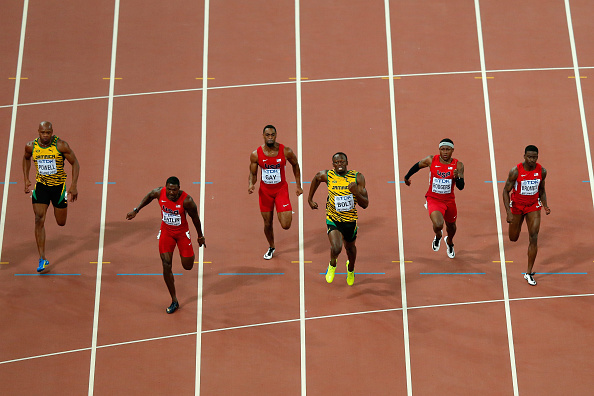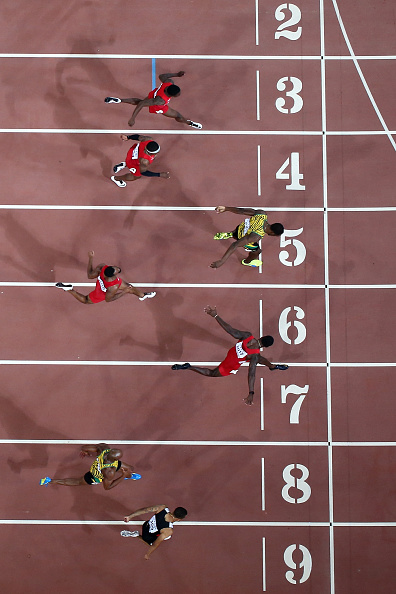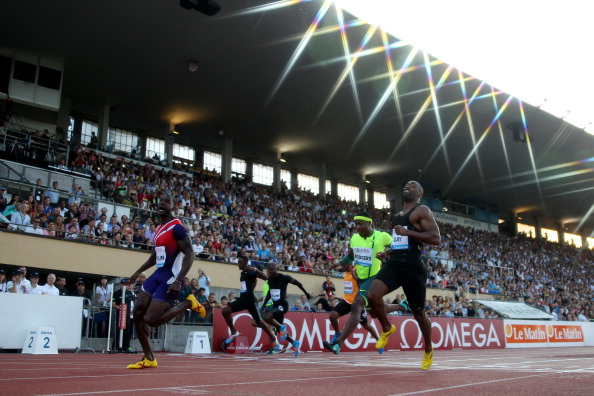EUGENE, Oregon — The weather forecast Sunday for the cathedral that is Hayward Field promised patches of sunshine. So apt. The U.S. team now heading to Beijing for the August world championships could be, may well be, the best-ever. Don’t say 30 medals. But, you know.
At the same time, can this team, this sport run away from the storm clouds? Say Justin Gatlin. Say Galen Rupp. You know.
Gatlin, who hasn’t lost at the 100 or 200 meters since 2013, ran away with the 200 Sunday at the U.S. nationals, ripping off a 19.57. That was a new U.S. outdoor national championships record. It made for the fifth-fastest 200 ever.

Gatlin’s performance highlighted a meet at which the U.S. team served notice of depth across the board. When Allyson Felix wins a 400 in which Sanya Richards-Ross doesn’t even make the final and Francena McCorory takes fourth — that’s evidence of how good the Americans are, and that’s just one event.
The list of potential multiple medal events is long. Just for starters: men’s shot put, men’s and women’s sprints, men’s and women’s sprint hurdles, men's triple jump (four qualifiers, all from the same university -- Florida, go Gator fans).
The U.S. women are really good in the 800 — Alysia Montaño winning Sunday in 1:59.15, Brenda Martinez just back in 1:59.71, Ajee' Wilson coming in third in 2:00.05 on one shoe. Maggie Vessey fell and didn’t have a chance.
At last year’s championships in Sacramento, Montaño was heavily pregnant with her first child, a daughter, Linnea, born last Aug. 15. You want sunshine?

As the U.S. team proved in the Bahamas this past May, it now has the recipe, assuming of course no baton drops, to beat Usain Bolt and the Jamaicans in the men’s 4x100 relay.
The key is getting way ahead of Bolt by the anchor leg. It’s simple: Gatlin, who runs one of the middle legs.
Take it to the bank: head to head, Gatlin, right now, absolutely would beat Bolt at both marquee distances, 100 or 200, and it might not even be close. Line them up: Gatlin is your guy. Bolt’s 2015 best in the 200, just as a for instance, is 20.13 in the Czech Republic on May 26.
So: how is Gatlin, age 33, 11 years after winning the 100 at the Athens Olympics, running better and faster than ever? More to the point: is Gatlin running clean? Better question: what if, truly, he is?
Questions, questions, questions all meet long for Rupp. There were British reporters here for the duration, and not for the Oregon sunshine.
Rupp, and his coach, Alberto Salazar, have been at the center of doping-related allegations for the past several weeks. All smoke, no fire. But a lot of smoke. Like, a lot.
Rupp is the London 2012 silver medalist in the 10,000 meters — behind his Oregon Project teammate, the British runner Mo Farah, who in recent days has been facing the same sorts of questions. Here on Friday, Rupp won the 10k and on Sunday took third in the 5k. Rupp also put on a bravo performance for the media after that 10k, scrupulously sticking to talking points, and talking points only — oh, and was that his agent, and Bolt’s as well, Ricky Simms, right there?
“I believe in a clean sport,” Rupp said, time and again. “I’m not going to lie. It’s been hard,” he said, over and again. And so on.
As was observed in the press tribunes at Hayward — so curious that Bolt did not run this week in Jamaica. Maybe Simms had more pressing business in Eugene.
Earlier this month, ProPublica and the BBC published allegations by, among others, the U.S. distance runner Kara Goucher and a former Salazar assistant, Steve Magness, that Salazar encouraged elite runners at the Oregon Project, which he leads, to push if not skirt anti-doping rules.
On Wednesday, just before the start of the meet here, Salazar published a 12,000-word online manifesto disputing the allegations. The Oregon Project, he said, “will never permit doping.”
A significant chunk of those 12,000 words went toward Salazar’s relationship with Goucher.
On Sunday, after her 5k-race, in which she finished 18th, Goucher said she doesn’t like “being labeled a liar.” At the same time, she asserted her “love for the sport is much stronger than my passion to have people like me.”
She said she first met with the U.S. Anti-Doping Agency on Feb. 1 or 2, 2013. Why that hadn’t emerged until now, she said, will all come out in due time.
“I believe in the truth,” she also said, “and I know that these things take time. I believe USADA is doing everything in their power. Think of how long it too for Lance,” a reference to the cyclist Lance Armstrong, “and I believe the truth will come out.
“When, I don’t know.”
Gatlin, meanwhile, who is often labeled a two-time doping loser, tried something of a media reach-out strategy here, talking to Reuters and to Sports Illustrated in a bid to get ahead of what he and everyone in the sport knows is going to be the other major U.S. track storyline come August and Beijing.
This is how it’s going to be: Tyson Gay, who served a one-year ban, won the 100 here on Friday, in 9.87 — his first world championship slot since 2009.
This is also how it’s going to be, absent injury or something freaky:
This year, Gatlin has run 9.75 and a world-best 9.74 in the 100. The sprints historically have been the domain of the Americans. Yet Gatlin would be the first American to get back on top of the world-scene sprint podium since 2007 — since Gay won the 100 and 200 at the worlds in Osaka, Japan.
It's all been Boltus Interruptus since, if you will, albeit with that 2011 worlds 100 false-start hiccup for Yohan Blake.
Bolt’s best 2015 100 is a 10.12, in April — though he did run a fantastic anchor leg at the World Relays.
Maybe the yams in Jamaica will prove super-potent this summer, or something.
Otherwise, this is a pretty easy call.
On Sunday, after winning the 200, referring to that Bolt-led Jamaican sprint domination of the past few years, Gatlin said, “I think a lot of sprinters are waking up and understanding that, you know, it’s time to fight back. It’s time to be able to represent your country. It’s time to work hard and go out there and bear your American flag with honor.”
Is the world, captivated by Bolt since 2008, ready for Gatlin to rule the sprints in Beijing? At the very Bird’s Nest where Bolt became, well, Bolt?
“You know what? I don’t know. At this point in time, all I can worry about is myself. That’s all I can do. I can only wake up as Justin Gatlin and go to sleep as Justin Gatlin.”
Earlier in the meet, Gatlin had suggested to Reuters that his first doping matter — when he tested positive in 2001 for an attention-deficit disorder medication — doesn’t deserve, really, to be counted.
“Last time I checked, someone who takes medication for a disorder is not a doper,” he said.
“Other people in the sport have taken the same medication I had for ADD and only got warnings.
“I didn’t,” a two-year ban that was later cut to one.
Gatlin’s second go-around with the doping rules has proven far more problematic.
In 2006, Gatlin tested positive for testosterone. He has consistently maintained he was sabotaged by a massage therapist with a grudge against his former coach, Trevor Graham; the therapist is alleged to have rubbed testosterone cream onto Gatlin at the 2006 Kansas Relays.
Query: does that pass the my-dog-ate-the-homework test?
Gatlin got four years.
He was eligible for eight but argued, successfully, that the ADD strike shouldn’t count against him in aggravation.
So — to his position.
Gatlin told SI, “That makes me a two-time doper? I don’t understand that at all,” and the man has a genuine point.
The hangup for many is the sabotage story. Maybe it's true. Maybe it's not. Without more in the public domain, who can say?
In the end, the thing is, Gatlin has done his time. The rules say he can run. What more, now, should the guy do?
If he were to get caught again, surely Gatlin -- who is a smart guy and has been around -- knows the consequences. It'd be over and done, however many prior strikes he wants to count. Is that risk worth whatever reward?
How about this: if this were the NFL, would this be such a big deal? Don't those guys get busted all the time, and it's small-point news in the back of the newspaper? Why is it seemingly such a bigger deal in track and field?
All of you who now want to stand up and scream, lifetime ban for even a first offense! Go away. That's not feasible, because of right-to-work and other legitimate concerns. If you want to mutter and sputter about such things over a pint in a pub, fine. The rest of us are going to live in the real world.
So what is it? Is track the last refuge of moralists? Come on. The world is not black and white. It's full of shades of grey. Elite track and field is, in every way, big-time, professional sport. So are sprinters supposed to be held to a different standard than linebackers? Really? Why?
So what is it?
Is it that, at 33, Gatlin is running so damn fast?
What explains that?
His 2004 best in the 100 was 9.85. Now he’s a full tenth of a second faster, and every sign is — aiming toward August — he probably will go faster still.
Until Sunday, Gatlin had a 2015 world-leading 19.68 in the 200 — here at Hayward, at the Prefontaine Classic, on May 30.
He ran a 19.92 in the first round, then 19.9 flat in the semis, then that 19.57.
His 200 times were all in the 20s until last year, when he posted 19.68 in Monaco.
The testing system is too fraught with uncertainty to declare that Gatlin — or, for that matter, anyone — is 100 percent clean.
For instance, and without reference to Gatlin — or, again, anyone — the British newspaper the Daily Mail on Sunday, quoting the American Victor Conte, the doping expert at the center of the BALCO scandal who now is in the supplement business, explained in lay terms the art of using a slow-acting substance called IGF-1 LR3.
Total cost for a 40-day cycle: as little as $200. Use: 100 micrograms per day.
“I believe there is rampant use of it right now,” Conte told the paper.
Then again, it is also the case that Gatlin is 25 pounds lighter than he was in 2010. What sport scientists have discovered is that upper body weight is, literally and figuratively, a drag for sprinters. Be as scrawny as you want up top. Just be able to pound it, and hard, with your lower body, because that’s what exerts mass and force.
If you’re carrying 25 pounds less, it stands to reason that you might well run faster, right?
Even a lot faster.
What if, for the sake of argument, Justin Gatlin is indeed running clean? What then?
“When you come out to Hayward Field,” Gatlin said atop the medals stand, “you have to come out and make a statement.”
“Look out, Jamaica?” Dan O’Brien, the 1996 Olympic decathlon champ who was doing PA duties at Hayward.
“Look out world,” Gatlin said. “Here we are — USA!”





























